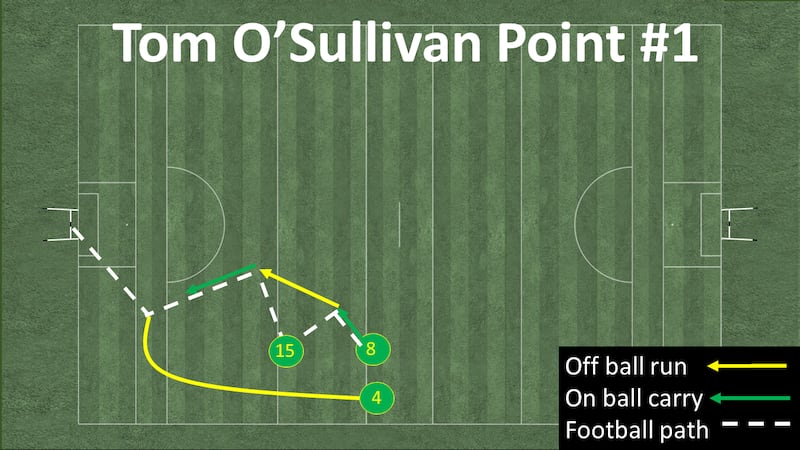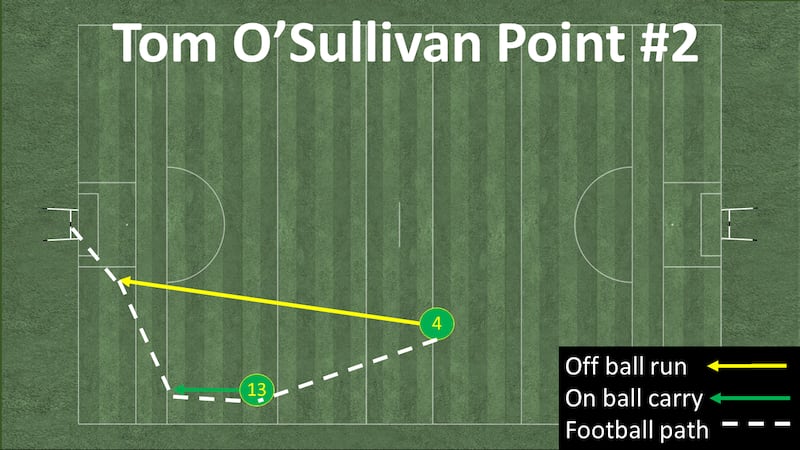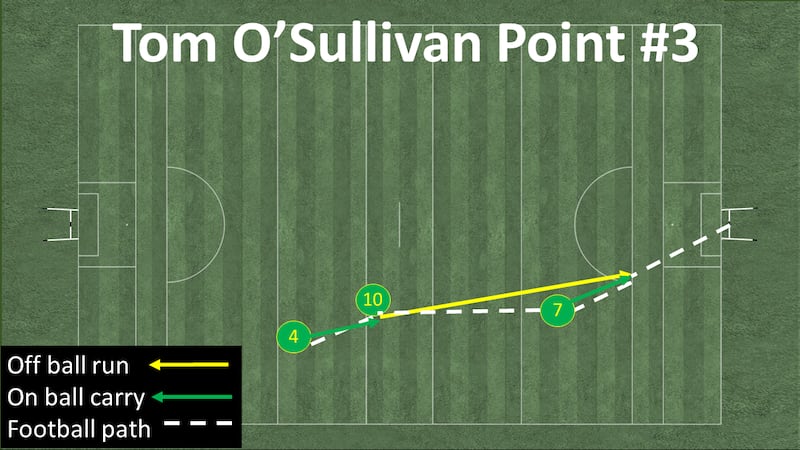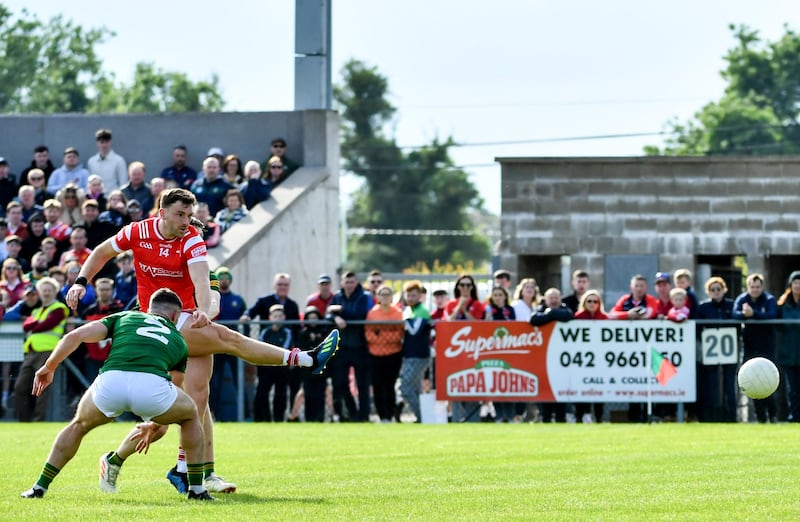The opening eight games of the All Ireland football series didn’t exactly blow us away as there is an air of inevitability to the results. From an attacking perspective a few teams are showing improvements, but for many others there is lot of work still to do.
Alternative attacking threats
There have long been questions about Kerry adding to their attacking arsenal of Sean O’Shea and the Clifford brothers. It has not been easy identifying new threats but Tom O’Sullivan has been consistently contributing to their attack and against Monaghan he was ably assisted by Paul Murphy.
Corner backs are meant to defend and play ball safely. Tom O’Sullivan got an early point against Monaghan off his left foot from a trail run, to open his account. The pick of his scores was an exquisite score which he started and finished – he kicked a 50m pass to David Clifford, before following that pass up with an 80m run and then hand passing over the bar, leaving Monaghan defenders for dead as they didn’t recognise the threat of his run.
In the 46th minute he again had an attacking involvement which he hand passed to Dara Moynihan, before getting on the end of the move two passes later to get his third point, this time off his right foot. He also assisted a Paul Geaney point in the second half.
READ MORE
O’Sullivan also had a first half assist for the other Kerry corner back, Paul Murphy, leaving him a personal tally of 0-3 and 0-2 in assists. Murphy got a second point, following a trail run very similar to O’Sullivan’s first point. This run by their corner backs is a definite ploy by Kerry and a hard one for opponents to mark when they are coming off first phase attacks before the opposition can set their defence.



Closing the loop
The loop from inside to out or from the sideline cutting across the ball carrier has long been an attacking trait of Mayo’s. They looked to manufacture this type of attack against Cavan on numerous occasions, resulting in 0-6 scored. Ryan O’Donoghue and Cillian O’Connor are excellent proponents of this movement.
They looked to work it on another four occasions, however this did not yield a return despite the set up being good. They missed two shots when it was the right option to shoot, and gave up another opportunity through indecision resulting in a dummy solo when the shot was on. The fourth error was a third man tackle after the loop – the screen on the defender needs to be more subtle. They are likely to face far more sophisticated defences than Cavan in the weeks ahead, so they will need to have far greater variety to their attack.
Attacking frailties
Meath looked clueless in attack as they lost a championship encounter to Louth for the first time in 49 years. Productivity is a measure of successful possessions, a measure of scores per every 10 team possessions. Meath over the entire first round of qualifiers had the lowest productivity of all teams. They only managed to score 0-9 from 37 team possessions, or 2.43 points per 10 possessions.
When you align that alongside some of the standard bearers it is a massive concern for manager Colm O’Rourke. Dublin were 6.76 against Roscommon and Donegal were 5.68 against Tyrone. Meath really struggled to deal with Louth’s blanket defence. They also really missed the creativity of Shane Walsh in their blunted attack, as no player managed to get more than a single score from play.

Louth were met with the opposite in terms of the Meath defence, which was extremely open leading to three first half goals. This allowed Louth to shut up shop even further with their commanding lead. Interestingly from an attacking perspective Louth didn’t have many sterile lengthy possessions and looked to attack with pace. Ger Brennan and Louth were rightly praised for their Leinster final performance against Dublin, where they completely gave up Dublin’s kickouts and set up a deep block. They had a similar approach for all Meath’s kickouts, with the caveat of pushing up on two kickouts following scoreable frees, and this brought an immediate return as they won both contests in the middle, one of which led to their opening goal by Sam Mulroy in the 13th minute.
Predictable Roscommon
Roscommon lagged behind Dublin in a number of areas when they met in Croke Park at the weekend. Dublin were set up extremely well as John Small nullified All Star Enda Smith across both halves, managing three turnovers on the Boyle man. Stopping the go-to Roscommon man meant they were fighting an uphill battle.
However, Roscommon went into half-time only one point behind, as they had an outrageous shot efficiency of 90%. Diarmuid Murtagh, Daire Cregg and Conor Cox were all on top in their individual battles in the opening period. A well-worked attacking ploy from Roscommon in that opening half was their ability to work double wraparound movements, amassing 0-3. This first half shooting efficiency wasn’t maintained as Dublin figured Roscommon out at half time. Roscommon didn’t manage to score any more of these double wraparound movements in the second half and only scored 0-4 in the second half from 14 team possessions, not managing to score after the 53rd minute.
Davy Burke could well have been satisfied at this point as they only trailed Dublin by two points, but they subsequently conceded 2-4 without registering themselves. Roscommon staying in the game was a product of the low level of team possessions, but they had to come out a little to try and win the game and Dublin punished them with two quick-paced attacking goals.
The kickout battle was another area where Roscommon really struggled as they failed to win a single Stephen Cluxton restart, as they tried at times to push up but were easily picked apart. On the other side, Dublin managed to win 8/14 (57%) of the kickouts Conor Carroll sent to the middle third, suggesting a predictable kickout strategy.
The nature of the competition structure means we are still likely watching some contending teams in secrecy mode, not yet willing to fully show their hand.
Paul O’Brien is a performance analyst with The Performance Process (twitter.com/NoPlanBGAA).














